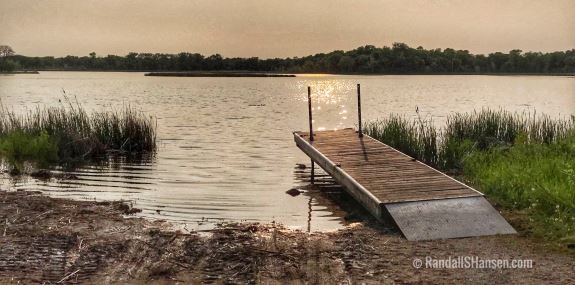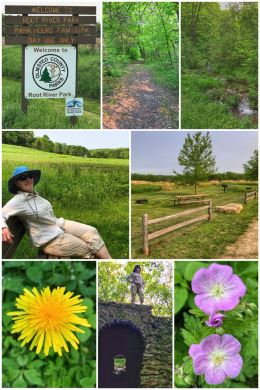
We started our adventures in Minnesota, the 23rd state on our quest to see the continental 48 during this 2.5-year road trip, in the southwest part of the state in Rochester — better known for being the home of the Mayo Clinic than anything else.
Fun facts: The state is named after the Dakota Indian name for the Minnesota River — Minisota — which means sky-tinted water. One of the state’s nicknames is the Land of 10,000 Lakes, but in reality, the state has more than 15,000 (though several thousand of those are now dry; officially, the state has recorded almost 12,000 lakes 10 acres or larger)… most of these lakes were were formed long ago during the last Ice Age when glaciers moved back and forth across the state creating kettle holes that became filled with water. Minnesota also has three diverse vegetative zones, from the tallgrass prairie in the west, to deciduous and hardwood forests, to coniferous forests in the northeast.
Rochester surprised us in its size and diversity of people. While the Mayo Clinic (which employs about 35,000 physicians, scientists, and health staff) and IBM (which now employs about 2,700 people, down from a high of around 8,000 years ago) may be part of the reason, we wondered about what else brought people to this city of about 155,000.
The city, conveniently located along the Zumbro River (a tributary of the Mississippi River), started long ago as a stop along the Dubuque Trail, a stagecoach line between St. Paul, Minnesota, and Dubuque, Iowa. Rochester got its name after the then much-larger city in upstate New York.
We got our first nature fix in the area by hiking the 2-mile loop trail in the 125-acre Root River Park, located about 11 miles southeast of town. The trail meanders through meadows and wooded hills down along Root River (also a tributary of the Mississippi River), and provides visitors with a variety of trail vistas. Along the river, one can witness 90-foot tall limestone bluffs carved by ancient glacial activity. On top of the bluffs, interspersed with the hardwood forest typical of this area, is a stand of native White Pine that is unusual in Southern Minnesota. The structure Jen is standing on in the first collage is a remnant of earlier days when stagecoaches made their way through the land.

The next day, we decided to get our nature fix by combining it with our rail-trail fix — by biking the Douglas State Trail, a 12.5-mile multiple use paved trail developed along the former rail corridor of the Chicago Great Western Railway. (A secondary, parallel trail has a natural surface for horseback riders and snowmobilers.) The trail travels through some wonderful rural scenery, traversing some of the richest agricultural land in Minnesota, as well as crossing the Zumbro River and two creeks. As you can see in the pictures, it also goes through forested land, and is shady in many parts of the trail. While the trail begins in northwestern Rochester and travels through the town of Douglas (for which the trail is named) before terminating in Pine Island, we actually started the trail from Pine Island’s City Park and biked down to Douglas before heading back — for a total of about 16 miles.
For those more interested in the Rochester area, the Douglas Trail connects directly with the Douglas-Cascade Trail, allowing folks access to Rochester’s extensive 60-mile trail system within the city.

Our ulterior motive for biking from the Pine Island trailhead was visiting a grass-fed, grass-finished, fully pastured small cattle ranch also located in Pine Island: Misty Meadows Farm, located about 15 miles north of Rochester.
Why grass-fed, grass-finished, pastured, and local beef? We are working on an article on that topic, but the bottom-line is that this beef is much more healthy for you than the store-bought, grain-fed beef. Completely grass-fed beef has a plethora of health benefits.
Paul and Lela Wiens, owners of Misty Meadows, raise pastured beef and chicken — all free of growth hormones and antibiotics… and all raised naturally and humanely. They state: “We believe God has given us our farm to raise healthy food to share with others.”
Misty Meadows has been raising Scottish Highland breed of cattle, but have recently switched to Murray Gray, a medium-sized and docile breed of Australian polled (no horns) beef cattle that graze well, resulting in a very tender meat.
Their model is to be good stewards of the animals AND the land; in fact, they practice an intensive grazing method that regularly move the cattle to “greener” pastures — which we witnessed firsthand when Paul took us around the farm’s 40 acres, visiting the two areas where the cows were grazing. (You can see how happy and healthy the cows look in the photos!)

We ended our time in the Rochester area with a bit of Minnesota wine-tasting, visiting two “local” wineries, starting with Salem Glen Winery, located about 10 miles southwest of Rochester. The family-run winery was established in 2006 on an old dairy farm in the Zumbro River Valley — and specializes in producing small batches of wine from regionally grown grapes. The winery sits on beautiful grounds, and we enjoyed the tasting, but found many of the wines a bit too tart for us.
We then traveled down to Four Daughters Vineyard & Winery, located 23 miles south of Rochester; but it’s not just a winery by any means, as it is also a cidery, restaurant, and event center. (They also have 6 acres of vines planted.) They offer 4 tasting flights — with no options or substitutions — and they lay out the entire flight in tiny little wine glasses that you pour into a full-size glass. They produce wines from their estate grapes as well as from grapes brought in from California. We found their wines and their prices a bit too much, but did leave with a bottle of their Polygon Rose (produced from their own grapes).
We then continued our travels northward through Minnesota, camping in the Clearwater/St. Cloud area. (We avoided the Minneapolis area, as we do for most large cities on this adventure, except for stopping for a much too-short visit with some old high school friends of Jen’s — and new friends of Ran — Scott and Heather.) Before ending the visit, we made plans for a return visit to the area, perhaps on our return back to Washington.
We camped in Clearwater, a mile or so from the where the Clearwater River empties into the Mississippi River in one of the few areas where the Mississippi is designated as wild and scenic, and just a few blocks from the Mississippi River Trail (MRT) — a 3,000-mile biking route that starts in the headwaters at Lake Itasca (further north in Minnesota) to near the mouth of the river in Venice, Louisiana, following mostly country roads but also — when possible — on shared, multi-use trails.
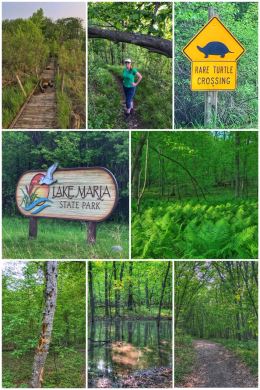
Our first adventure in the area was a hike down to Riverside Park along the Riverside Bike Trail. The Clearwater River was raging when we visited and the hike was perfect. It was during this hike that we discovered the MRT.
We later drove to Lake Maria State Park, located about 11 miles south of Clearwater, and home to the endangered Blanding’s turtle, as well as the “Big Woods,” a maple, oak and basswood forest — one of the last remaining stands that once covered more than 3,000 square miles in this area before being clearcut for industry, farms, towns, etc. Blanding’s turtles are classified as a threatened species in Minnesota, and are one of the longest living turtles (many live 70+ years), but they also take 20 years or so to reach sexual maturity — and sadly, a vast majority of their eggs are eaten by predators.
The park offers a variety of camping and hiking options, as well as boating opportunities.
We enjoyed hiking two main trails within the park, starting with the Bjorkland Trail, a 2-mile loop through meadows and forest, with a short peak at Bjorkland Lake (Maria Lake), the namesake of the park. (We tried to research why the two names, but never found any answers.) We then drove down to the picnic area near Little Mary Lake (Maria) and hiked the 1-mile Zumbrunnen Interpretative Trail, which goes from forest to marsh, and has lots of cool signs (about trees, animals, and plants) providing information along the way.
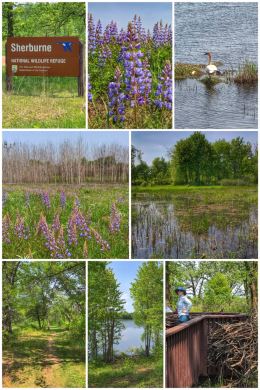
We finished our time in the Clearwater area with a trip out to the Sherburne National Wildlife Refuge, located about 20 miles east of town. The 39,700-acre refuge, established in 1965, protects mixed habitats of the St. Francis River Valley for migratory birds and other wildlife. The park encompasses wetland, oak savanna, and prairie habitats — with the majority off limits to visitors from March 1 to August 31 as a designated wildlife sanctuary and breeding ground. The refuge offers a wide variety of activities for visitors, including a wildlife drive, hiking trails, canoeing, and hunting and fishing.
We started our visit driving the 7.3-mile Prairie’s Edge Wildlife Drive, which features four wildlife observations decks and three short walking trails. When we drove it, one section of the drive was just covered in a field of wild lupines, one of our favorite wildflowers — and which we have missed since our time in the Pacific Northwest last spring. We discovered on this trip that lupines are part of the legume (Fabaceae) family and enhance soil fertility by fixing atmospheric nitrogen into a useful form. While we did not see them, Sandhill Cranes, Blue Herons, Cormorants, Bald Eagles, and variety of waterfowl (including swans, which we did see) are found here.
After the drive, we headed to the refuge office to help us decide which of their two trails to hike. We discovered that a part of the 5-mile Blue Hill Trail was closed because of flooding (from both the rains and a pesky beaver), so we hiked the 3-mile Mahnomen Trail, which was quite lovely.
Fun fact we learned on the trail: Mahnomen is an Ojibwe word for wild rice — derived from Manitou (meaning Great Spirit) and meenum (meaning delicacy); others say the name for wild rice is manoomin, meaning the “good berry.” Regardless of the exact name, at one time, wild rice grew abundantly in shallow lakes and slow-moving streams throughout Minnesota. The wild rice is also called Canada Rice, Indian Rice, and Water Oats (a species of grasses forming the genus Zizania). The rice is consumed by waterfowl and other aquatic wildlife — as well as by humans. There are three species of wild rice native to North America, with Northern Wild Rice is native to the Great Lakes region of the U.S. and Canada, including Minnesota. In stores all through Minnesota, we have found packages of (dark, long-grain) wild rice products.
(By the way, the Ojibwe, Ojibwa, Chippewa, or Saulteaux — sometimes used interchangeably — are an Anishinaabe people of Canada and the United States, living mainly in Michigan, Wisconsin, Minnesota, North Dakota. They are one of the most numerous indigenous peoples in North America, the second-largest First Nations population, surpassed only by the Cree.)
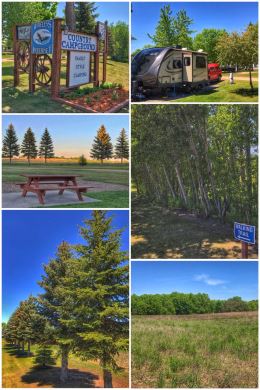
Our third camping stop in Minnesota was in Detroit Lakes, which is an amazingly beautiful area, with lakes EVERYWHERE! The town is definitely a tourist attraction — bringing in large numbers of tourists and seasonal residents for the many recreational activities in the town and all the lakes. We figured if it was good enough for John Steinbeck, why not us? (Just kidding, though Steinbeck mentions the town in his 1960 novel, Travels with Charley.)
We have stayed in hundreds of campgrounds through this journey, and as you might have noticed rarely mention them because we have often been disappointed — by the WiFi, or the bathrooms, or the laundry, or the rudeness of the managers (or sometimes the other campers) — but not only are we mentioning Country Campground, we are featuring the beauty of the park with these photos.
This campground has something for everyone! It has two fenced playgrounds for the kids, a recreation hall with all sorts of fun games (and where Jen and I played table tennis — ping pong — every single day), horseshoes and other outside games, a hiking trail, laundry room, and cable channels. Each RV site is wide and has a picnic table and campfire ring. They also have two Paddle Boats you can take out onto Glawe Lake, a small private lake — and all these amenities are included in the price. Perfect.
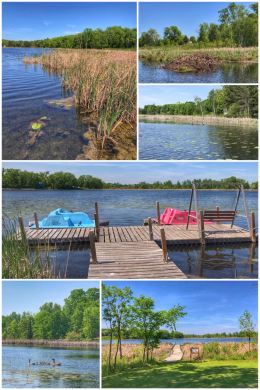
Our only disappointment was the lack of WiFi. Their main WiFi got struck by lightening and they are in the process of adding a whole new system… Understandable, but they should mention that fact when people are making reservations. Happily, we have our mobile phone hotspots and overlooked this major flaw because the feel of this place is special.
The park is just five minutes south of downtown Detroit Lakes, which has some great stores and restaurants…. and, the Detroit Lakes Public Library — a Carnegie Library built in 1913.
We spent the first afternoon on the paddle boats, which you can see in the collage… it’s a pretty (and very clear) little lake and we were happily surprised to see several swimming turtles — and a wonderful Goose family, with NINE goslings!
We had been itching to get back on the water for weeks now and hoped that we would finally have decent weather in Minnesota — and it did not disappoint.
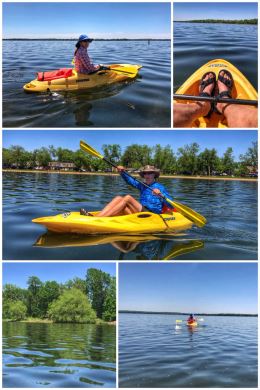
The next day, in fact, we decided to go kayaking on the actual Detroit Lake, which is known for the mile-long city beach on its west side.
The 3,000+ acre lake, about 90 feet at its deepest, is certainly a center for recreation, with several swimming areas, boat launches and docks. The lake is also used for fishing, water sports, and scuba diving. Fish in the lake include several types of bass, pike, walleye, and bullhead.
We rented individual kayaks and hit the lake, paddling along the western and southern ends before heading back. (We had a great time on the lake — even with Ran’s kayak being a bit too small for him and Jen’s paddle length also being a bit too short for her.)
We might have hit the water trifecta with floating a river, but only discovered the day before we were leaving that two places offer a 2-hour tube ride down the Otter Tail River: Charlie’s Ottertail Tubing and K & K Tubing.

We ended the first half of our nature adventures in Minnesota with one of our favorite activities — visiting a national wildlife refuge. Located about 18 miles northeast of Detroit Lakes, the 43,000-acre Tamarac National Wildlife Refuge was established by Congress in 1938 to protect the breeding grounds of migratory birds and other wildlife. The entire purchase of the land came from the sale of Federal Duck Stamps, and early development of the refuge (including roads, trails, and buildings) was accomplished by the Civilian Conservation Corps (CCC) in the 1930s and 1940s. The refuge has a beautiful visitor center, so we started there and enjoyed sitting on the observation deck and watching lots of birds (attracted by a variety of feeders)… and one cute little squirrel picking up leftovers on the ground. The visitor center has a short film, but somehow we missed it, and the volunteer we chatted with did not mention it.
From the visitor center, we hit the Blackbird Wildlife Drive, a 5-mile self-guided trail open from April 15 through December 15 (depending on road conditions), which has great signage and information — just make sure to pick up the brochure at the visitor center before making the drive. The drive goes through forested areas and bogs, and alongside Blackbird and Pine Lakes.
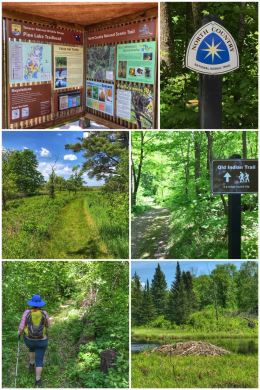
While we did not see any common loons, Minnesota’s official state bird, we did encounter the unofficial state bird on our hike on the Old Indian Trail — in fact, we ran into swarms of them… mosquitoes, and they were hungry for blood! We have never hiked so quickly in our lives, completing the 2.3-mile hike in record time! The trail follows an ancient Native American trail used for wild ricing, maple syruping, and hunting — and we had hoped to see some wildlife (other than mosquitoes) and some of the older maple trees — but we were too busy powering our way past the pests to really enjoy our surroundings. We did stop and enjoy a beaver dam, as shown in the picture collage.
We had planned to also hike a good part of the North County National Scenic Trail, a 4,600-mile trail that cuts through the refuge… but on this day, the mosquitoes won out and we only hiked about 100 feet on the trail before seeking refuge back in the truck! This trail is the longest of 11 national scenic trails in the United States, and is administered by the National Park Service; it starts in North Dakota (475 miles) in the west, continuing into Minnesota (775 miles), Wisconsin (200 miles), Michigan (1,150 miles), Ohio (1,050 miles), and Pennsylvania (265 miles) before ending in New York (625 miles); at some point, the trail will continue into Vermont. As is typical with these newer scenic trails, not all segments have been completed, so make sure you have a current map before setting out. You can learn more about the trail here. We hope to hike more of the trail as we continue heading eastward — through all those states! (Ran has a special place in his heart for these trails, especially after serving on the official Advisory Council for the Pacific Northwest National Scenic Trail, administered by the U.S. Forest Service.)
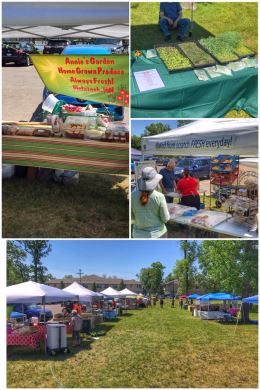
Our last day in Detroit Lakes involved a bike ride to the local Farmers Market; now that summer is near, we hope to visit as many of these markets as we can along the journey. It is vital to support our local farmers and ranchers as best we can — and shopping at your local farmers market is the easiest way to do so, while also gaining access to the freshest of local vegetables and fruits.
The Lakes Area Farmers Market runs from May through October on Tuesdays and Saturdays. On the Saturday we went, there were a small number of vendors — most with soaps and canned goodies still, but a we loved finding a vendor selling sprouts (we bought a bag of sunflower sprouts for our salads). We also bought a dozen fresh farm eggs (the best you can buy). We were tempted by a local baker selling a variety of breads (and other sweet treats), but decided against it as it was neither non-GMO nor organic.
Next up? We continue our journey into Minnesota, with a stop at Bemidji to visit Paul Bunyan and Babe, as well as the headwaters of the great Mississippi River.
